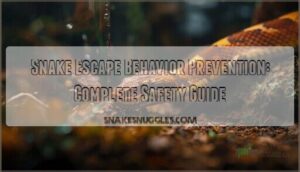This site is supported by our readers. We may earn a commission, at no cost to you, if you purchase through links.

The difference between breaking even and building a profitable breeding operation comes down to research before you ever pair your first snakes. Smart breeders study MorphMarket trends like day traders watch stock tickers, tracking which color mutations are climbing in value and which once-expensive morphs have flooded the market. They calculate feeding costs against potential returns, factor in the two-year timeline before hatchlings reach breeding age, and understand that a $10,000 snake means nothing if you can’t find buyers.
This guide walks you through the strategic decisions that separate hobbyists from profitable breeders—from choosing species with strong market demand to setting up efficient breeding facilities that scale without draining your profits.
Table Of Contents
- Key Takeaways
- Choosing Profitable Snake Species
- Setting Up a Successful Breeding Facility
- Managing The Snake Breeding Process
- Incubating Eggs and Raising Hatchlings
- Marketing and Selling Snakes for Profit
- Frequently Asked Questions (FAQs)
- What are the best snake species to breed for profit?
- How do I set up a proper breeding environment for snakes?
- What is the process for managing the breeding process?
- How do I properly care for snake eggs and hatchlings?
- What are the most effective marketing strategies for selling snakes for profit?
- What permits or licenses are required for breeding?
- How do you handle snake health emergencies?
- What shipping methods work best for live snakes?
- How can you prevent inbreeding in small collections?
- What insurance protects breeders from potential liabilities?
- Conclusion
Key Takeaways
- Profitable snake breeding hinges on strategic species selection—designer ball python morphs can fetch $10,000 to $30,000 while oversaturated markets like standard corn snakes have crashed from $75 to $40, making market research and timing as critical as genetics.
- Your breeding facility setup directly impacts profitability through proper biosecurity, temperature control within 2-3 degrees, and efficient enclosure design—cutting corners on environmental controls leads to respiratory infections, failed clutches, and unmarketable hatchlings that kill your margins.
- Documentation separates professional breeders from hobbyists—tracking lineage, genetics, reproductive cycles, and pairing outcomes transforms breeding from gambling into predictable profit by allowing you to command premium prices for proven bloodlines.
- Most breeding operations fail within 18 months because operators treat it like a hobby instead of a business—success requires balancing years of care costs against volatile market shifts, building buyer trust through customer service, and navigating legal requirements like breeder licenses ($100-$500 annually) and interstate sale regulations.
Choosing Profitable Snake Species
Not every snake species will put money in your pocket—some are far more profitable than others. Your success as a breeder depends on choosing the right animals from the start, balancing market demand with your ability to produce healthy, desirable offspring.
Let’s look at the key factors that’ll help you make smart decisions about which species to breed.
Researching High-Demand and Rare Snakes
You’ll want to start by diving into Morph Market Analysis and tracking which species command premium prices—ball pythons with designer genetics consistently top profitability charts, while locality-specific demand for green tree pythons and hognose snakes can fetch $350 to $1,000 per animal.
Study supply and demand in the reptile market through online forums and reptile shows, paying close attention to genetic trait research and conservation impact studies that affect Import/Export Regulations before committing to breeding snakes.
Understanding the pet snakes market is essential for making informed decisions about which species to breed and sell.
Evaluating Market Prices and Trends
Once you’ve spotted high-demand species, track real-world Market Analysis data to optimize Profit Margins. In 2024, designer ball python morphs sold for $10,000 to $30,000, while standard corn snakes dropped from $75 to $40–$50 due to oversupply—proof that Price Trends shift fast.
Monitor online platforms like MorphMarket and reptile shows to forecast Demand and calculate Breeding Costs against potential returns. Understanding supply dynamics helps you avoid oversaturated markets and focus profitability on rare morphs where selling offspring actually pays off.
To stay competitive, it’s vital to research the reptile pet supply market and its trends.
Assessing Breeding Challenges and Care Needs
Before you chase high-dollar morphs, figure out if you can actually keep them alive and breeding—because a $5,000 snake that won’t eat or reproduce is just an expensive pet.
Research Snake Health Issues like respiratory infections and breeding stress that plague delicate species. Factor in Habitat Design complexity, Feeding Strategies for picky eaters, and hatchling care demands.
Prioritizing Animal Welfare and understanding breeding costs upfront separates profitable reptile breeding from money pits.
Setting Up a Successful Breeding Facility
Your breeding facility is where the magic happens—and where problems can start if you cut corners. Getting the setup right from day one saves you headaches, lost animals, and money down the road.
Here’s what you need to focus on to create a space that keeps your snakes healthy and your operation profitable.
Designing Optimal Enclosures and Habitats
Your breeding facility’s foundation isn’t just four walls and a lock—it’s the difference between healthy, marketable hatchlings and costly failures that’ll drain your profit margins faster than you can say "stuck shed."
Start with stackable PVC or melamine enclosures—they’re easier to clean and hold thermal gradients better than glass tanks. Choose substrates like newspaper or cypress mulch based on your species’ needs, and don’t skimp on proper ventilation systems to prevent respiratory infections that’ll tank your reputation and breeding costs.
Controlling Temperature, Humidity, and Lighting
Get the temperature wrong by even three degrees, and you’ll watch your breeding season—and your profit—slip away as eggs fail to develop or hatchlings emerge with deformities that make them unsellable.
Invest in thermostat-controlled heat cords and digital hygrometers for each enclosure—not guesswork. Most species need basking spots around 88-92°F with ambient temps in the low 80s, while your incubator demands rock-solid stability at species-specific parameters, usually 78-84°F depending on what you’re breeding.
Ensuring Biosecurity and Animal Welfare
A single sick snake can rip through your collection like wildfire—taking your reputation, your investment, and months of careful genetic planning down with it.
One sick snake can devastate your entire collection, destroying your reputation, investment, and months of careful breeding work
Disease prevention starts with strict biosecurity protocols and hygiene practices that protect animal welfare in breeding operations.
Your non-negotiables for animal husbandry:
- Quarantine new arrivals for 90 days minimum—no exceptions, regardless of source
- Disinfect tools between enclosures using reptile-safe solutions to prevent cross-contamination
- Touch animals only when necessary, washing hands between specimens to minimize stress and pathogen spread
Sound welfare standards aren’t just ethical—they’re your insurance policy against devastating losses in reptile breeding expenses.
Managing The Snake Breeding Process
Getting your snakes to breed successfully isn’t just about putting a male and female together and hoping for the best. You’ll need to understand pairing strategies, recognize the subtle signs of reproductive readiness, and keep detailed records of every breeding.
Here’s what you need to manage throughout the breeding process.
Pairing and Mating Techniques for Snakes
Successful pairings don’t happen by tossing two snakes together and hoping for the best—timing, compatibility, and strategic matchmaking separate amateur attempts from profitable clutches.
You’ll want to introduce breeding-age pairs after proper cooling periods trigger their reproductive health and mating behaviors. Study your species’ breeding cycles, select for desirable genetic traits, and watch for courtship signals—these breeding practices guarantee your reptile breeding efforts actually produce marketable offspring instead of wasted seasons.
Monitoring Reproductive Cycles and Behaviors
Once your snakes are paired, the real work shifts to reading their body language and tracking the subtle hormonal shifts that signal whether you’re heading toward a profitable clutch or an empty season.
Watch for post-mating behaviors—females often refuse food and show thickening mid-bodies signaling egg production. Track breeding seasons carefully, noting mating rituals and reproductive health markers.
These breeding practices let you predict ovulation timing and prepare incubation setups before your investment literally hits the ground.
Documenting Genetics and Lineage
Think of your breeding records as a genetic roadmap—without clear documentation of lineage, morphs, and inheritance patterns, you’re gambling blind instead of stacking the odds in your favor.
Log each snake’s pedigree, track hereditary traits across generations, and use genetic testing when working with complex morphs.
This breeding discipline turns guesswork into predictable genetics—and predictable genetics into premium pricing that separates serious breeders from hobbyists playing with reproduction.
Incubating Eggs and Raising Hatchlings
Once your snakes have mated and laid eggs, the real work begins with proper incubation and hatchling care. Getting the temperature and humidity right can make or break your clutch, and those first few weeks after hatching are critical for establishing healthy feeders.
Let’s walk through the essential steps to optimize your hatch rates and raise strong, sellable snakes.
Best Practices for Egg Collection and Incubation
The moment your female lays her clutch, the clock starts ticking—how you manage those eggs in the first few hours can make or break your entire breeding season. Here’s what you need to nail:
- Egg Management: Mark the top with a pencil immediately and transfer eggs to your incubator without rotating them—flipping can drown developing embryos.
- Incubation Mediums: Use vermiculite or perlite mixed 1:1 by weight with water for ideal humidity control and gas exchange.
- Temperature Stability: Set your incubator between 78-84°F depending on species—even 2-degree swings can cause deformities in hatchies.
Maintaining Ideal Conditions for Hatching Success
Getting eggs into the incubator is half the battle—keeping them there under rock-solid conditions for 55 to 80 days is where most breeders either cash in or watch their investment rot.
Check your incubator daily for temperature drift and humidity swings—digital hygrometers don’t lie, but analog ones will cost you hatchies.
Resist the urge to candle eggs obsessively; excessive manipulation stresses developing embryos and tanks your hatch rates fast.
Feeding and Caring for Young Snakes
Fresh hatchlings won’t eat for 5 to 10 days post-emergence, and pushing food too early just spooks them into a hunger strike that’ll drain your margins. Once they shed, offer appropriately sized prey—snake nutrition starts with pinky mice or rat pups depending on species.
Smart hatchling care means tracking three things:
- First feed acceptance (marks healthy young snake health)
- Weekly weight gain (growth monitoring catches failures fast)
- Shed quality (dull sheds signal husbandry problems)
Master these feeding techniques and your breeding experience shifts from babysitting to banking—healthy hatchlings sell themselves.
Marketing and Selling Snakes for Profit
You’ve got healthy hatchlings ready to go—now it’s time to turn your breeding operation into actual profit.
The marketing side of snake breeding can feel tricky at first, but with the right approach to building trust, reaching buyers, and pricing your animals, you’ll find your groove.
Let’s break down how to get your snakes in front of the right people and close those sales.
Building Your Reputation and Customer Base
Your reputation in the snake breeding community isn’t built overnight—it’s earned through consistent quality, honest communication, and delivering exactly what you promise to every customer.
Start by providing outstanding customer service—answer questions promptly, share your breeding experience openly, and follow up after sales. Positive online reviews and social media engagement become your best marketing tools as trust building establishes credibility.
Word-of-mouth referrals from satisfied customers drive the long-term profitability of reptile breeding more than any advertisement ever could.
Advertising Online and at Reptile Shows
Tap into the power of Digital Marketing to put your breeding snakes as a business in front of motivated buyers. The market for snakes thrives where supply and demand in the reptile market converge—online and in person.
- Social Media and Reptile Forums – Share photos, genetic details, and care tips to build credibility while connecting with collectors seeking specific morphs.
- Online Classifieds – List available hatchlings on platforms like MorphMarket to reach buyers actively searching for their next purchase.
- Show Displays – Attend reptile expos to network, showcase your animals, and prove the profitability of reptile breeding through face-to-face sales and making money from reptiles.
Pricing Strategies and Legal Considerations
Set prices based on Market Trends and morph rarity—ball pythons with sought-after genetics sell for $500 to $10,000, while normals go for $10 to $50. Factor in Breeding Costs, shipping, and seasonal demand when Price Setting.
Legal Compliance matters: over 30 states require breeder licenses ($100–$500 annually), and the Lacey Act governs interstate sales.
Track Tax Implications and maintain sales records to protect your breeding snakes as a business from penalties up to $5,000 daily.
Frequently Asked Questions (FAQs)
What are the best snake species to breed for profit?
Ball pythons and corn snakes dominate profitable snake breeding—they’re forgiving for beginners, produce stunning morphs, and maintain strong market demand.
Species rarity matters, but breeding costs and supply and demand in the reptile market determine your actual profit margins.
How do I set up a proper breeding environment for snakes?
Proper breeding snakes starts with spacious snake enclosures that allow natural movement and thermoregulation. Environmental control matters—install gradient heating, humidity monitoring, and lighting systems that mimic natural breeding climate.
Habitat design should include hiding spots, water access, and easy cleaning access to maintain biosecurity.
What is the process for managing the breeding process?
Managing snake breeding starts with proper pairing—you’ll select compatible breeders based on genetics and health.
Track reproductive cycles, document each pairing’s lineage, and monitor mating behaviors closely.
Keep detailed breeding records to improve your mating strategies and maintain strong bloodlines over time.
How do I properly care for snake eggs and hatchlings?
Once eggs arrive, incubation begins—steady temps around 88-90°F and high humidity are non-negotiable. Check daily for mold or collapse.
After hatching, your hatchlings need proper husbandry: small enclosures, correct heat gradients, and their first meal within ten days.
What are the most effective marketing strategies for selling snakes for profit?
Success in snake sales isn’t about charming your way through—it’s about visibility. Leverage Social Media platforms, engage in Online Forums, and use Email Marketing to reach enthusiasts.
Customer Reviews build trust, while tracking Market Trends helps you align breeding projects with market demand. Combine reptile care expertise with smart supply and demand awareness.
What permits or licenses are required for breeding?
Most reptile breeders need permits from state fish and wildlife agencies, plus a USDA license if selling across state lines.
Requirements vary widely—some states demand facility inspections, while others ban certain species outright.
Check local and federal regulations before pairing your first snakes.
How do you handle snake health emergencies?
When trouble strikes, don’t let it rattle you—quick action saves lives. Keep an exotic vet’s number handy and watch for warning signs like lethargy or respiratory distress through health monitoring systems.
Snake disease management starts with prevention, but emergencies demand immediate veterinary care, especially for snake bite treatment during breeding season interactions.
What shipping methods work best for live snakes?
You’ll want overnight shipping through FedEx or UPS with specialized reptile packaging—insulated boxes, heat or cold packs depending on season, and breathable deli cups.
Ship Monday through Wednesday only to avoid weekend delays, protecting your snakes and breeding reputation.
How can you prevent inbreeding in small collections?
Track lineages carefully and rotate unrelated bloodlines into your breeding program every few generations.
You can also partner with other breeders to exchange animals, preventing genetic bottlenecks while maintaining genetic diversity in your small collection.
What insurance protects breeders from potential liabilities?
You’ll need general Liability Coverage and business insurance that includes animal-related incidents—escapes, bites, or property damage.
Specialized Reptile Insurance policies protect your breeding operation from lawsuits while safeguarding your financial outlay and assets, addressing essential liability and ethical considerations of breeding responsibly.
Conclusion
Most breeding ventures collapse within eighteen months—not from bad genetics, but from treating this like a hobby instead of a business.
Learning how to breed and sell snakes for a profit demands the precision of a geneticist and the instincts of a trader. You’re betting years of care costs against market shifts that can crater a morph’s value overnight.
But nail your species selection, perfect your husbandry, and build buyer trust? You’ve built something rare: a reptile operation that actually pays you back—with offspring worth more than their weight in scales.
- https://docs.google.com/forms/d/1GAQr3Kn1cURCVHUA82hAga1Wv8DCH0IuqDLRUrOpN7M/viewform?ts=63f4f653&entry.1515682415=https://www.merriam-webster.com/dictionary%2Fbreed
- https://premium.britannica.com/mw-unabridged/?utm_source=mw&utm_medium=inline-def&utm_campaign=evergreen
- https://dictionary.cambridge.org/dictionary/english/american-bully?topic=breeds-and-breeding
- https://www.freethesaurus.com/breed
- https://medical-dictionary.thefreedictionary.com/breed












